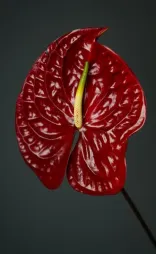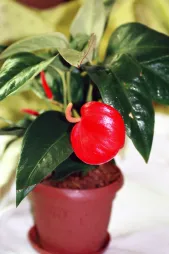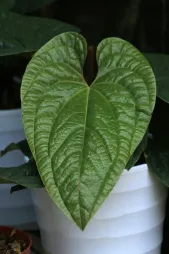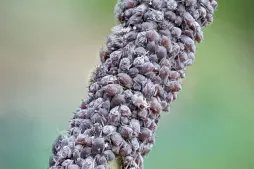Anthurium crystallinum, a plant with velvety leaves
In the movies, when adventurers enter the South American jungle, it's always to explore the ruins of a temple or a gold mine. If I were in their shoes, I'd go in search of exotic plants like Anthurium crystallinum. With its velvety, deep-green leaves, this root that grows in Panama and Colombia is worth all the world's treasures.
How to recognize Anthurium crystallinum?
An epiphytic perennial with a bushy habit, Anthurium crystallinum measures 90 centimetres in all directions.
Leaves can reach 30 centimetres in length. Thick and heart-shaped, they have a velvety texture. The upper surface of the leaf blades is a dark green, darker than in anthurium clarinervium. Theunderside is a lighter green, sometimes with coppery highlights.
Flowering occurs at any time of the year. The flower consists of a brown spathe surrounding a lighter spadix.
Once pollinated, the inflorescence gives rise to a purple berry.
Anthurium crystallinum is slightly toxic to animals if ingested. Keep it out of the reach of your dog or cat. Its sap can also cause skin irritation. Don't hesitate to wear gloves when pruning or repotting the plant.
Our maintenance tips
Watering
To know if you need to water, touch the soil. Water only when the surface of the substrate is dry (two to three centimeters). Use non-calcareous water, such as rainwater, at room temperature.
To prevent the roots from suffocating, don't leave standing water in the saucer or planter.
To prevent the roots from suffocating, don't leave standing water in the saucer or planter.
Repotting
Every spring, repot your Anthurium crystallinum to give it more space.
Repot your Anthurium crystallinum in a pierced plastic potone size larger than the previous one. Choose a transparent model so you can check humidity levels and root condition.
Anthurium crystallinum need a light, airy substrate. For example, you can mix potting soil for epiphytic orchids, perlite and a little peat moss.
Line the bottom of the pot with your growing medium. Plant your specimen in the center and add substrate. Stop two or three centimetres before the edge to leave a watering trough.
Water for the first time to encourage rooting.
Fertilization
To promote the growth of your Anthurium crystallinum, apply fertilizer in spring and summer.
Apply green plant fertilizer in addition to watering.
Cleaning
When dust accumulates on the leaves, the plant slows down its photosynthesis process and its growth. To keep your Anthurium crystallinum healthy, clean its foliage with a damp, clean cloth.
Anthurium crystallinum are toxic plants. Wash your hands after touching your plant, or wear gloves when handling it.
Cutting
Cutting is carried out during the strong growth phase, generally in spring and early summer.
A few weeks before harvesting, surround the stem with sphagnum moss. Wrap the moss in transparent cling film. Mist regularly to keep the moss moist. This technique allows the stem to develop roots, increasing the chances of success for the cutting and survival for the mother plant.
When the roots are five centimetres long, you can cut the stem. Take Anthurium crystallinum out of its pot and remove the sphagnum moss to observe the root system. Make a first cut to separate the plant from the underground roots and part of the stem. Cut off a portion containing the leaves, part of the stem and the roots formed by the sphagnum moss. Use a clean, sharp tool.
You can divide the rest of the stem into several sections. Be sure to retain some roots and a knot in each section.
Prepare a rich, draining mix. You can mix potting soil for green plants with bark, perlite or vermiculite. Fill plastic cups.
Then plant your cutting. Bury the roots, but let the stem rest horizontally on the substrate in the open air.
Cuttings are more likely to take root in a smothered environment. Place them in a translucent box or mini-greenhouse. Place in a sunny spot where the temperature is at least 20°C.
Mist as needed to maintain a high level of humidity, and air for a few minutes a day to prevent rotting.
Diseases / Threats
Information
| Family | Araceae - Araceae |
| Type | Anthurium - Anthurium |
| Species | Anthurium crystallinum - Anthurium crystallinum |
| Lifecycle | Perennial |
| Foliage | Evergreen |
| Exposure | |
| Substrat | |
| Planting method |
In pots |
| Categories | |
| Tags |
Fritillary Toxic |
| Origin |
South America |
| Hardiness (USDA) | 11b |
| Leaf color |
|
| Flower color |
|
Discover plants from the same family

Anthurium andreanum
Discover

Anthurium scherzerianum
Discover

Anthurium clarinervium
Discover

Anthurium luxurians
Discover

















